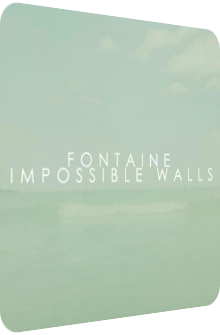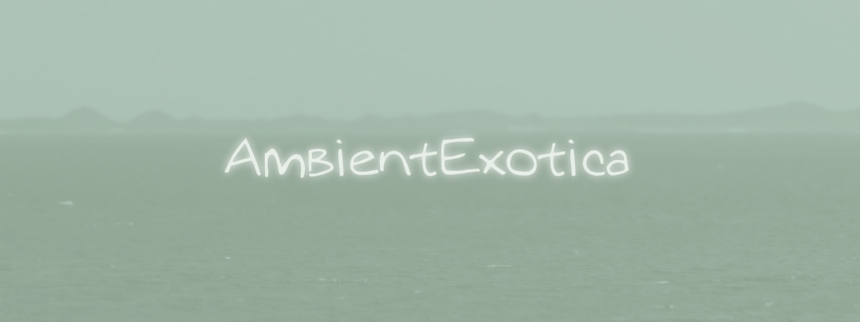
Fontaine
Impossible Walls
2014
Fontaine belongs to the ocean, other antagonists have the sky as their limit. Video game nerds will nod in agreement, and so will Ambient and Drone fans who favor synth-encapsulated movements. Bristol’s Fontaine aka John Doak makes it look so easy on his dank debut album of aquatic-aquiline aquicludes called Impossible Walls. Released on New Year’s Day 2014 on Cory Zaradur’s more than fitting Calgary-based Inner Ocean Records and available to purchase and stream at Bandcamp, its six original tracks and two remixes by Calgary’s Valiska (Krzysztof Sujata) and Berlin’s Window Magic (Andreas Bonkowski) are delightfully focused, carefree and incredibly deep. While this is the debut album of Fontaine, he has already offered Drone-centered parallax entities in tandem with cautious Rave vestiges heretofore with his actual debut EP Delays (2012, Twice Removed Records) and the follow-up Weirdo Haze (2013, Inner Ocean Records). Previously sadness-evoking and torn by elegiac contemplation, Fontaine has now fully submerged into Drone territory, with even the most pointillistic melody being planed into a shapeshifting plateau of gaseous formations, letting refractions and luminosity glint through the nebulous moiré.
The quadruple legacy of Wolfgang Voigt aka Gas has shown the possible enchantment of these aesthetics: the beat-driven synthetic movements imposed by Gas, Zauberberg, Königsforst and Pop are bewitching, as are the processed recordings of horns and strings, but what remains most remarkable to this day is the surreal haze amid them, be it vinyl crackles or cascades of pink noise. It is this sylvan resin that is taken ten miles yonder down below – and counting… – by Fontaine. The soft green fluxion is stupefyingly relaxing and soothing, John Doak shies away from any possible cliché. No seagulls, ocean wave, oxygen tank or air bubble make their way to any of the arrangements; a refreshingly notional approach, even in view to the interwoven and alienated looped samples from both the artist’s own works and those of others. I consider myself a big fan of John Doak’s music, but even I cannot pinpoint one translucent instance of an admixed work. Notwithstanding my incompetence in this regard (and others, sigh), here is a meticulous look at all eight tracks, with an enlightening ratiocination coming up in the later paragraphs.
At the infancy stage of Impossible Walls, i.e. during the opener High Altar, the tendency of submergence is anything but a mere snapshot, as this piece is the widest, most vaulted one. More of a subterranean crystalline cavity than a city on the ocean floor, Fontaine injects cavalcades of Bengal firework whose colors become aurally visible via gigantic amounts of reverberation, pristine afterglows and coruscating sparks, all of them signature elements of the artist, brought to the foremost foreground for the first time. Fir-green synth-oid piano movements flow in the distance, functioning as convex indentations for the amalgamation of hisses. This is a magical place, seemingly existing independently of the human conception. This airy gateway leads to the first fully elaborate aquaculture called Grails. There is a prominent two-tone movement grafted onto the silkened splutters, resembling the mechanical respiration of a submarine. These two tones are at the same time the only golden thread that resembles some sort of melodious vestige. Hovering above helical sediments and fizzling adjuvants, Grails is mellowness transformed into sound waves, again concentrated only on its own state of existence, shimmering in cyan colors. The mood is hard to pinpoint. It is neither joyous nor enigmatic. It lets the listening subject feel weightless and fully content. In a similar but much more bubbling fashion, Impossible Walls showcases its highly euphonious pith with great prowess. Its yellow-golden luminescence shimmers through the vesiculating polka dots, uniting drone washes with strongly cushioned staccato hiccups of the arpeggiated kind. With its surroundings literally watered down, the harbored synth braiding multiplexes seduction, divinity and redemption. The artist sent me the track in spring 2013 already, and what I mused back then still rings ever-true: whereas Fontaine’s layers were heretofore always hidden behind a melancholia, he now brings the notion of bliss to the forefront via cherubic synth seraphims, harp-like bubbles and a mint green haze to cherish.
The following three tracks are Fontaine’s first thematic triptych. Called Trieste I, II and III, they are dedicated to the northeastern city of Italy. Connected to the Adriatic Sea, the total runtime of roughly 17 minutes allows the listener to fathom the surroundings via a soft focus lens. Trieste I carves out John Doak’s vision of ecclesiasticism qua its elasticized but harmless chime chimeras, fluttering steadying columns and iridescent-polyhedron beams of aquatic aurum. The listener encompasses these unfolding events through a dive bell which mutates the frequency range. The heavily plinking and glistening strata are consequentially limewashed, all jags and spikes annihilated. Faint wellsprings bubble through the well-lit ether, letting Trieste I appear like a humongous treasure chest of gemstones, capturing the gaze of the bystander (or -swimmer), never letting him or her move away past the chatoyant elysium. Eventually, Trieste II starts regardless, further streamlining the comparatively mercurial light refractions of Trieste I via a distantly brazen stokehold aorta whose equally faint portent is but a mere faraway ferocity in-between the condensed aurora of quasi-insouciance. Indeed, the depth of field is augmented, infinitesimally shadier undercurrents find their way into the scenery. Trieste II appears slightly dun-colored, its intensity hatched, but threatening or ill-natured it is decidedly not. But it hints at the things to come: Trieste III progresses into more abyssal sections, spiraling downwards to darker territories. The concatenation of the foggy drones turns vermeil, with specks of rust-brown pigments. These impressions coincide with – and are nurtured by – a deeper pitch. Fontaine tones down the formerly blistering glow and is leads, as the very end of the album shows, to a gurgling maelstrom watched from afar.
Valiska appears during the remix appendix, having a remix of Grails with him. This turns out to be a magnifying glass of the aggressive kind. It is as if Krzysztof Sujata encountered Fontaine’s original and wanted to break through that effervescent synth spheroid at all costs. In order to accomplish just that, rough tools are required. What better way to break through an impossible wall than with the help of harassing fire and smoke grenades? After a choked-up omnium gatherum of static noise expectorations, Valiska reaches the enchanted core, looks through a microscope that unveils its frolicking particles, but alters the perception. The synth structure now seems etiolated, cauterized even, and more ashen. It has not lost anything of its former magic though. Living up to his own set of aesthetics, Sujata continues to mould the juice of static noise rhizomes into the segment, adding the sleet and convulsion to Fontaine’s work that feel like welcome antibodies. Like a figment, the remix comes to an abrupt halt, making room for a diffuse liquor of acid that trickles for another twenty seconds, leading to Window Magic’s Reimagining of Trieste III. Realized by means of tape manipulation, Andreas Bonkowski creates a delightfully entangled turmoil of landslides, rockfalls and warped wonkiness. Only a few seconds shy of the twelve-minute mark, the artist discovers the truthful characteristic trait that is hinted at in Fontaine’s original Trieste III: an Industrial nullspace. The remix merges sawtooth train brakes with short eruptions chopped à la Thomas Fehlmann, glues their fugacious energy together in order to simulate a cohesive legato layer, and shakes the blotchy ingredients in the test tube, thereby creating the liveliest, most vertiginous superimposition. Recalcitrant and astray, epitomizing the cheeky antipode of Fontaine’s vision, coxswain Bonkowski takes the listener to machine-populated asbestus grounds. Why, thank you!
From start to finish, Impossible Walls is the most coherent affair. Enormously mesmeric, wondrously soporific and with an increasingly kinetic depth effect, Fontaine’s journey seems to be on cloud nine, in seventh heaven, over the moon, on top of the world, whereas in the intrinsic set of realities it actually glides through the created inner ocean (!) of bliss. No chintzy stereotypes are attached, this ocean is an abstractly erudite one, sapient and profound. The omission of any field recording or echopraxia thereof is the utmost important solution and fends off the lure of putting this work of languor into the overcrowded seaside ambience. Aquatic Ambient is omnipresent, and via the couple of attenuation and abstraction, the artist defies being embedded in the nucleus of this movement. Euphony, elation and grandness are overabundantly available, readily swirling, emitting cavalcades of nautical hues, radiating saltatory salts as well as hypnotic helixes of haze. But this last state of matter, the haze I’m talking about, is truly it: the very impossible walls Fontaine is talking about, at least music-wise. It is the divider, the dash panel, the dive bell, and if one decided to overcome them, an overwhelming clarity would ensue.
In an – admittedly twisted – way, Fontaine’s Impossible Walls uses the same base and hence triggers identical synapses as the pre-millennial Glitch record of your choice: the state of distortion and the conglomeration of hyper-polished scything sine protuberances is as important a part of the skeleton as the hidden globs of jelly-like expanses coated in harmonies and actual melodic vestiges, i.e. the same ingredients that are demanded and unleashed in each and every Pop-oriented song. Naturally, Impossible Walls is no Glitch record in the end, not at all, but its factor of disturbance in the shape of a hardly penetrable haze is not only cautiously hinted at in the title, it is boldly constituted in all six original tracks. Take away the haze, and rich alluvial soils appear, basking in technicolor, sporting alkaline adornments and erbaceous embellishments. In the great shape of things, such beauty must not be. John Doak may have reduced his trademark reflectiveness and bittersweet enshrinement to a bare minimum, the interim result of this artistic approach, however, demands another contrapuntal source of gravity: aqueous haze. That the remixes of Valiska and Window Magic not only keep up with this very modus oceanus, but seemingly absorb it completely until a clearer, much more argentine realm is reached on the way towards the moonlit surface area, is an added bonus and tightly integrates with the liquedous endemics. I know right now, in this very moment, that this work will accompany me during desk-related tasks for multitudinous months to come. Reviewers are quick to name something a classic. I won’t do that. I will, however, state that Impossible Walls delivers everything I hoped it would be. The early pieces John Doak teased me with have become a congruent whole. The previous sentence only feigns precision and objectivism, as it continues to emit sparks behind the curtain, across the ocean… and abaft the impossible wall.
Further listening and reading:
- You can purchase and fully stream Impossible Walls at Bandcamp.
- Twitter galore: @jd_doak is Fontaine, @inner_ocean the label, and @TheValiska as well as @Window_Magic the remixers. A gentlemen’s club if there ever was one.
Ambient Review 303: Fontaine – Impossible Walls (2014). Originally published on Jan. 1, 2014 at AmbientExotica.com.
